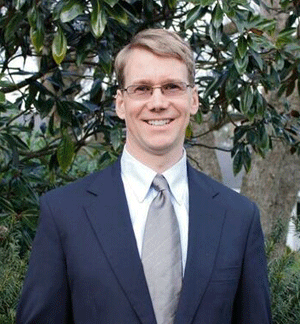Q. How did you begin your involvement with the BGF?
A. I’ve been interested in gardening since I was a kid helping my grandfather in his Chapel Hill garden. I love feeling connected to plants, and I visit botanical gardens when I travel. I’ve been visiting Coker Arboretum and Mason Farm and the main campus for years, long before I understood their connection to the Garden. But one day, Ken Moore and Bill Bracey came out to Fearrington for a chat, and soon thereafter I joined the board. That was a few years ago and I’ve had a chance to work with both Peter White and now Damon.
Q. How did your interest in native plants develop?
A. Only recently have I made the distinction between native and exotic plants. I’d always been curious about natives – I mean, you can’t live in the South without noticing the havoc exotic invasives have done to our landscape – but the Garden pushed it further for me. NCBG made the case that the plants that are found locally are best adapted to your climate and soils, and they support our bird populations. So for me now, native plants means biodiversity and sustainability – and really authenticity.
Q. What do you hope to accomplish as the president of the BGF? What are your major goals?
A. There’s exciting change at the Garden. There’s more public attention than ever to issues like climate change and preserving biodiversity and species habitats. We’ve settled into fantastic, new facilities and that has offered more ways to engage the public. And the University has invested in a full time – and terrific! – full time director. All these trends and developments are coming together to support the Garden’s mission in 2016, and we’re seeing this reflected in solid growth in Foundation membership levels.
The Foundation is here to support the Garden’s important work, and we’ve got to all be rowing in the same direction to do that. So I want board members to feel engaged and informed, and know how they can contribute to their potential. That means supporting the committees we’ve set up, removing road blocks that get in the way, keeping channels of communication open, and working effectively with Damon and his team. Together we can get a lot done.
Q. Tell us about your day job.
A. I’m in the business world. After working the corporate track in New York, I came back home almost a decade ago – I missed NC and well, I wanted to garden year round. I work with my dad, R.B. Fitch, and sister Keebe at Fearrington. In a small business you get pulled in a lot of directions and that’s fun.
My fun hat is working with our gardeners and groundskeepers. We’ve been shifting almost exclusively towards natives in our plantings. We have created a native wildflower garden and received Audubon certification as a bird friendly community.
Q. Do you have a favorite native plant? If so, why is it your favorite?
A. Wildlife ecology expert Doug Tallamy rates woody plants by their capacity to support biodiversity and he puts oaks at the very top. And white oaks (Quercus alba) take the prize for me for aesthetic reasons; no other tree has a more striking habit and achieves such a massive scale. They live forever if their roots aren’t disturbed. We’re lucky they were so commonly planted on campus and downtown.
Q. Where is your favorite place at NCBG?
A. There are many parts of the Garden I love, but what I enjoy the most is Mason Farm. I love seeing the Piedmont prairie in the former farm fields, the ever changing landscape, the new boardwalk, the peace and quiet of the place. John K. Terres’s description of its flying squirrels in his book cracks me up. We’re so fortunate that this parcel is protected and managed by the Garden.
